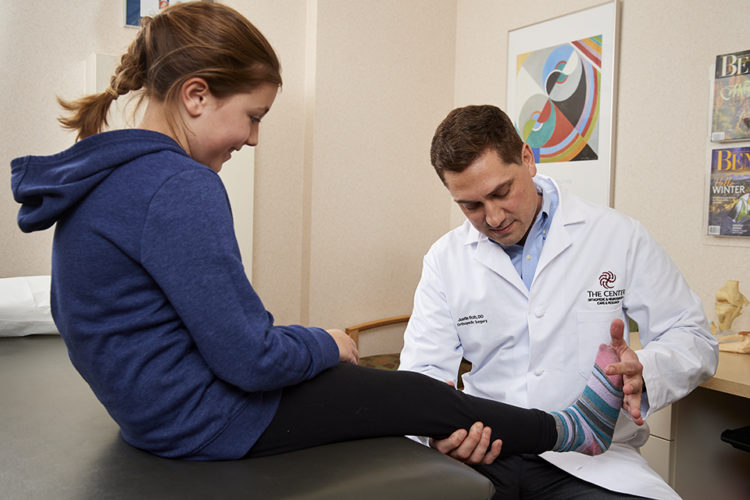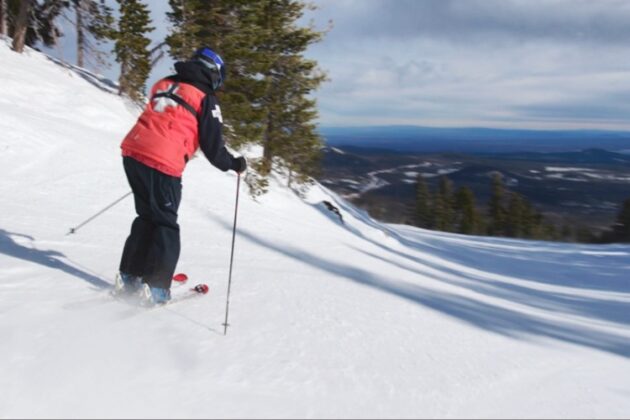
Pediatric orthopedist specialists from The Center answer the top five questions from parents including when a child should see an orthopedist for their pain.
Last fall my 12-year-old son joined the middle school cross country team, but he struggled with knee pain the entire season and missed several meets. He was super frustrated and tried everything from icing to wearing knee bands, but the pain persisted. The coach mentioned that he may have Osgood-Schlatter disease. Is this serious and will he be able to run track in the spring?
Osgood Schlatter’s disease is an overuse injury caused by irritation of the growth plate where the patella tendon attaches to the tibia just below the knee cap. This particular growth plate is under tension and tends to give kids problems in the adolescent years prior to their growth plates closing. The pain typically resolves around 14-16 years of age when the growth plate closes depending on an adolescent’s bone maturity. Just about any sport can exacerbate the condition if the growth plate is hypersensitive, but activities that commonly worsen the condition are running (track, cross country, etc.) and jumping (basketball). Treatment consists of a rest period (2-4 weeks or more), scheduled NSAIDs (nonsteroidal anti-inflammatory drugs) for 7-10 days, ice, stretching, and physical therapy.
Your child will likely be able to run track in the spring if he takes the diagnosis seriously and treats it appropriately. However, it may very well be a recurrent issue for him until the growth plate closes. If this is the case, he can run through it but at some point modifying your child’s activity becomes the only realistic solution. My second comment would be to make sure this is the correct diagnosis, anterior knee pain can be caused by a number of underlying issues that generally are all treated the same (rest, ice, NSAIDs, and PT), but if the pain persists he should get some imaging and make sure there isn’t a more serious issue.
We recently learned that our daughter’s joints are hypermobile. What activities should she avoid? What will help her?
Joint hypermobility is a wide spectrum of pathology from frank joint dislocation to being “double jointed” and can be very age dependent. By this I mean that your child may not yet have grown into her joints and thus hypermobility can improve with age and treatment. In general, avoid putting hypermobile joints in positions that cause discomfort. If it hurts, don’t do it. The discomfort is micro-instability or subluxation where, on a small level, the joint is dislocating. The mainstay of treatment is physical therapy for strengthening the muscles around the joint in question, which is effective in the vast majority of patients. What you don’t want to do is get to the point where your child has a complete joint dislocation event that causes tearing of the soft tissues around the joint. Most children and adolescents can get away with a single dislocation event and rehab effectively, but multiple dislocation events can be a surgical indication.
I’m still confused about ice versus heat, especially a week or more after the injury. What should I do when?
My answer to this is pretty simple; if the joint is stiff and hard to move then heat is advised to help with motion. Motion is healthy for joints. If the joint is swollen and painful from an acute injury or overuse, then ice is encouraged. My general rule for icing is 20 minutes on and 20 minutes off for 2-4 cycles. It is the cooling and warming cycles that helps most with the swelling and inflammation.
My 8-year old daughter loves sports! She plays soccer, basketball, lacrosse and even goes on runs on her own. Should I worry about her overactive lifestyle while she is still growing?
I would not worry, but I would suggest you do your best to help her prepare appropriately for the sports she loves. This includes stretching, warming up, and making sure that she knows her limits. Overuse injuries are very common in children and adolescents, so it is important for her to rest adequately if she complains of aches and pains. Cross training is excellent at any age. I worry more about the children that play the same sport year round on various club teams etc. These athletes tend to have higher rates of injury and, on a psychological level, are more likely to burn out earlier and lose interest.
When my child has pain, when should they see an orthopedist?
If there is an acute injury and a high level of concern then certainly the child/adolescent should be seen (i.e. can’t bear weight, significant swelling, etc.) by a pediatric orthopedist. However, I would caution parents about bringing the child in a few days after the injury if they are on the fence. Many lower grade athletic injuries in children and adolescents resolve in one to two weeks with a little rest and observation. If it has been a week or two and the pain/injury persists, then I would be thinking more about bringing the child in to be seen by an orthopedist. In all reality, I am going to get a better and more meaningful exam at one to two weeks after muscles have relaxed and swelling subsides around the injured area. We are always happy to see a patient and provide reassurance but often times in the acute phase I am going to observe the patient and have them come back in a week or two.
If the injury/pain is more chronic, then a good rule of thumb is to bring them in when the pain stops them from doing what they like to do (sports, dance, gymnastics, running, etc.)
Last, any joint/bone pain associated with fevers, redness, or swelling should be evaluated more urgently because children and adolescents can get bone and joint infections that would not surface in an adult because of the blood supply crossing their open growth plates.





